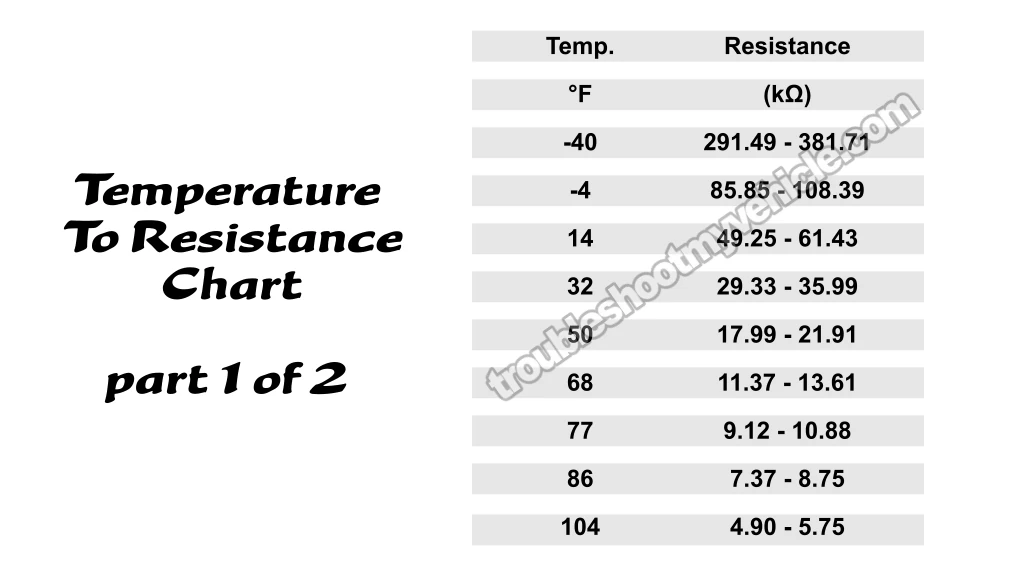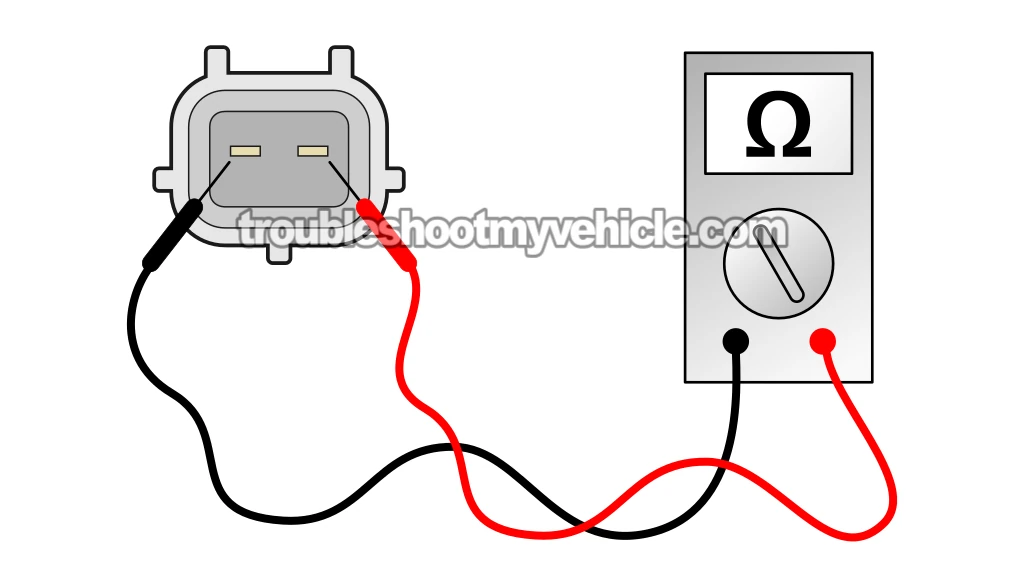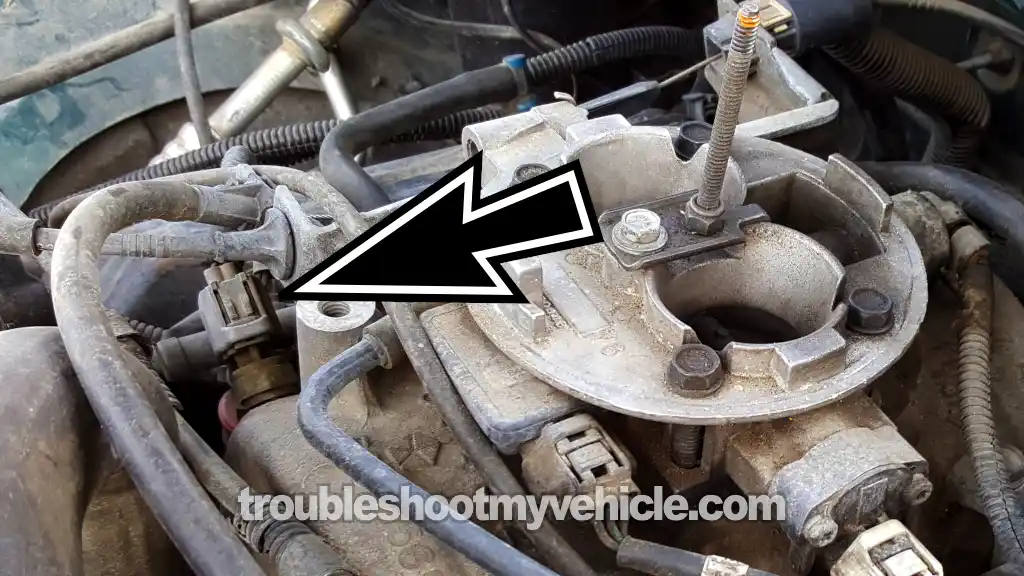
If you're seeing diagnostic trouble code (DTC) P0112 or P0113, your Dodge Ram van's PCM is letting you know that something is up with the intake air temperature (IAT) sensor.
In this tutorial, I'm gonna show you how to resistance test it with a multimeter -no scan tool required. And let me tell you, the IAT sensor on your Dodge Ram van is honestly one of the easiest sensors to check.
I'll also explain a few of the common issues that can trigger those IAT sensor codes (P0112 or P0113) besides a bad IAT sensor.
NOTE: The intake air temperature (IAT) sensor is also known as the air charge temperature (ACT) sensor.
Contents of this tutorial:
- Symptoms Of A Bad Intake Air Temperature (IAT) Sensor.
- What Does The Intake Air Temperature (IAT) Sensor Do?
- Common Intake Air Temperature (IAT) Sensor Problems.
- Quick Checks Before Testing The IAT Sensor.
- Where To Buy The IAT Sensor And Connector.
- Checking Temperature To Resistance Value Relationship.
- More 3.9L V6 Dodge Ram Van Tutorials.
APPLIES TO: This tutorial applies to the following vehicles:
- 3.9L V6 Dodge Ram 1500 Van: 1998, 1999, 2000, 2001, 2002, 2003.
- 3.9L V6 Dodge Ram 2500 Van: 1998, 1999, 2000, 2001, 2002, 2003.
Symptoms Of A Bad Intake Air Temperature (IAT) Sensor
When the IAT sensor fails, the PCM is gonna set an IAT diagnostic trouble code (DTC), and illuminate the check engine light (CEL). You'll see one of these codes:
- P0112: Intake Air Temp (IAT) Sensor Voltage Too Low.
- P0113: Intake Air Temp (IAT) Sensor Voltage Too High.
But the fun doesn't just stop at triggering the check engine light (CEL). A bad IAT sensor messes with your engine's performance in a bunch of ways:
- Hard starts: If the sensor gives off the wrong air temp reading —especially during extreme heat or cold— starting the engine turns into a challenge.
- No power: Feels like your engine's got nothing behind it.
- Rough idle: The engine might shake or run rough. You'll really notice it when you're in Drive, sitting at a stoplight.
- Engine stalling: The engine can suddenly shut off. It might stall while idling or just as you press the gas pedal.
- No-start: The engine starts and runs most of the time, but every now and then, cranks but won't actually fire up.
- Bad gas mileage: Since the PCM starts dumping in more fuel, you're gonna see your gas mileage drop off a cliff.
What Does The Intake Air Temperature (IAT) Sensor Do?
The IAT sensor works is a thermistor —a special type of resistor that changes its resistance based on air temperature. Its main job is to tell the PCM how hot or cold the air going into the engine is.
The PCM sends a steady 5 Volts to the sensor. As the air temp shifts, the sensor's resistance changes. That resistance change alters the voltage signal flowing across the sensor.
The computer reads that voltage and compares it to its own data to figure out the actual air temp heading into the engine.
Your 3.9L V6 Dodge Ram van runs a speed-density fuel system, not one with a MAF sensor. That means it doesn't measure airflow directly —it calculates it instead.
To pull that off, the PCM relies on three key sensors. With their data, it figures out how much fuel to inject into the cylinders.
Here's what it depends on:
- Engine RPM from the crankshaft position (CKP) sensor.
- Intake manifold pressure from the MAP sensor.
- Air temperature from the IAT sensor.
To sum it all up —the PCM uses info from the IAT, MAP, and CKP sensors to manage the air/fuel mixture, adjust spark timing, and keep your Dodge Ram's V6 engine running smooth and steady.
Common Intake Air Temperature (IAT) Sensor Problems
At some point, the IAT sensor's gonna stop working. These are the most common ways it fails:
- Wear and tear: Just like any other part in your Dodge Ram van, the IAT sensor ages. Sooner or later, it gives out.
- Open circuit failure: Inside the sensor, a break in its circuit can develop. When that happens, the PCM reads the intake air temp as crazy cold —usually around -40°F.
- Short circuits: In other cases, the sensor shorts out. That makes the PCM think the air temp is sky-high —like 248°F or more.
- Damaged wires: The insulation of the wires near the connector can crack and peel off. Once the copper's exposed, it doesn't take much for the wires to touch and short out.
- Broken connector: Even if you unplug the sensor carefully, the locking tab can snap. That's pretty common and leads to an intermittent false connection.
Any of those issues can send bad info to the PCM, which throws off how the engine runs and sets an IAT-related trouble code (DTC).
Quick Checks Before Testing The IAT Sensor
Before grabbing your multimeter to test resistance, take a minute to check for these common issues:
- Inspect the two wires coming from the sensor's connector. If you spot cuts, cracks, or other damage, fix those first — that might be all it takes.
- Check the connector itself. Make sure the tab isn't broken or missing, and that it's holding tight.
- Take a close look at the sensor's plastic top. Sometimes, it snaps right off the metal base.
One of the most frequent problems is frayed wiring right at the connector. Once the insulation falls off and the copper's showing, it's easy for the wires to touch and short out.
When they do, the PCM reads a fake high air temp — like 248°F or more — and throws the check engine light.
Here's a real-world example of this kind of damage:
- IAT Sensor Wire Insulation Problem And Wires Shorted Together (from easyautodiagnostics.com).
You've got a couple ways to deal with frayed wiring:
- If the damage is severe or right next to the connector, replacing the whole connector is the best option.
- If it's just a small section and farther down the line, electrical tape can hold you over for now.
NOTE: Electrical tape isn't a permanent solution. Whether the damage looks small or big, replacing the connector or fixing the wiring is the only real fix if you want it to last.
Where To Buy The IAT Sensor And Connector
Disclosure: As an Amazon Associate, I earn from qualifying purchases. If my tutorials help you, using these links is an easy way to support the site at no extra cost to you. Thank you!
Checking Temperature To Resistance Value Relationship
Like I mentioned earlier, the IAT sensor changes its resistance depending on the temp of the air moving through the intake manifold —that's the air your engine breathes in.
You can test that resistance with a multimeter set to Ohms. The number you get should match the air temperature around you (check the Temp-To-Resistance Chart above).
If the sensor's in good shape, its resistance reading will be close to what's on the chart —usually within 10 degrees of the actual outside temp.
If the sensor's shot, the multimeter's gonna show one of two things:
- Open circuit: You'll see "OL" on the display — that stands for "over limit", which means the sensor's internal circuit is open.
- Short circuit: If the screen shows "0 Ohms", then the sensor's shorted inside. It's bad and needs replacing.
IMPORTANT: Make sure the sensor's cold when you test it. It needs to match the outside temp for a proper reading. If the engine's been running, give it time to cool down completely before testing.
Alright, here's what to do:
- 1
Check the outside temperature.
Use your phone or a nearby thermometer. You'll compare this number with the resistance reading from the sensor. - 2
Locate the IAT sensor and unplug its 2-wire connector.
LOCATION: Look near the front of the intake manifold, on the passenger side. (Photo 4 in the viewer shows you exactly where it is). - 3
OPTIONAL: Remove the sensor from the manifold. Be careful —it breaks easy.
NOTE: You can test it while it's still installed, but pulling it out might give you more room to work. - 4
Set your multimeter to Ohms (Ω) mode.
- 5
Check resistance by placing the multimeter probes on the two male pins of the sensor.
- 6
Write down the resistance reading that shows up on the screen.
- 7
Match your reading with the Temperature-To-Resistance Chart (see the image viewer above).
The number should fall within about ±10°F of the outside air temp.
Here's what the results tell you:
CASE 1: The resistance is way off from what it should be based on current temps. That means the sensor's faulty. Swap it out.
CASE 2: The resistance matches what the chart says for your local temperature. Good news — the sensor's working like it should. No replacement needed.
More 3.9L V6 Dodge Ram Van Tutorials
You can find a complete list of tutorials for the 3.9L V6 Dodge Ram Van in this index:
Here's a sample of the tutorials you'll find in the index:
- How To Test The TPS (1997-2003 3.9L V6 Dodge Ram Van).
- How To Test The Fuel Pump (1992-2003 3.9L V6 Dodge Ram Van).
- How To Test For A Blown Head Gasket (1989-2003 3.9L V6 Dodge Ram Van).
- How To Test The Engine Compression (1989-2003 3.9L V6 Dodge Ram Van).

If this info saved the day, buy me a beer!








